Earlier this year, Tesla impressed a lot of people from the industry, as well as the general public, when it unveiled the refreshed Model S. One of the things that struck the audience the most was the claimed acceleration for the Plaid and Plaid+ variants. Tesla said, or rather says, that Model S Plaid can accelerate from 0 to 60 mph (96.5 kph) in 1.99 seconds. The Plaid+ variant, on the other hand, which is supposed to be the epitome of performance from the Californian automaker, can do it in less than 1.99 seconds. The exact timing isn’t known yet, but considering that Plaid+ will have a tri-motor powertrain compared to Plaid’s dual-motor, we can assume it will be faster.
Now, a sub-2-second timing for acceleration is quite interesting, because there are no production vehicles out there that have achieved it. Many cars find themselves just above this 2-second mark, but none of them has managed to achieve it. And so, any vehicle that does achieve it will obviously come under scrutiny. As has Tesla Model S. When you really read into the fine print, you will find out that the Model S Plaid does not, in fact, accelerate under 2 seconds.
Understanding the Theory behind Calculating 0-60 Timings
YouTube channel ‘Engineering Explained’ digs into the math of everything even remotely related to cars. Jason Fenske, who runs the channel, always releases such videos about different vehicles and helps bust some myths as well. He decided to actually understand the process of calculating the 0-60 mph acceleration timings of various vehicles.
Many magazines test out new vehicles and their acceleration tests normally have one thing in common. There is a laser beam that controls the automatic timer for these tests. When the test vehicle cuts this beam, the timer begins. However, the starting point of the vehicle is around 1 foot (30.48 cm) behind this laser beam. This means that all vehicles get around one foot of free acceleration, post which the timing gets calculated.
Now, the magazines that release this acceleration data always notify their readers of this anomaly. Tesla, however, seems to have taken the advantage of this error. Nowhere on the main page of vehicle specs can you see the reality of these acceleration tests. But if you check in the details of the spec sheet, there is an asterisk beside the acceleration timings of Plaid and Plaid+ variants. And the asterisk denotes “subtracting first foot of rollout”.
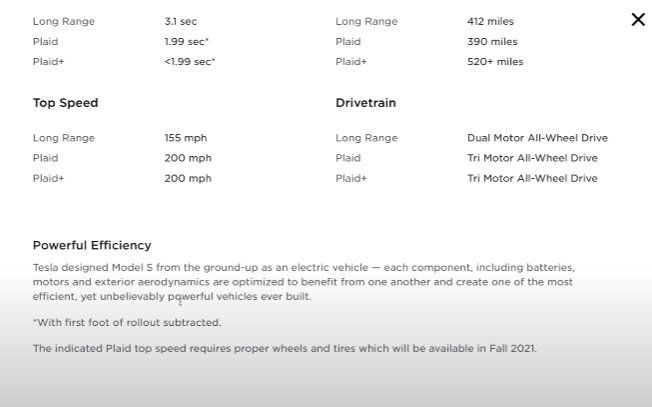
Effect of this Rollout Error
Now, you may think that this is not a very big deal. But when you’re talking about timings in milliseconds, every small detail matters. For example, the magazine Motor Trend carried out some tests which gave them interesting results.
Tesla Model S P100D, an older version of Tesla’s premium sedan, accelerates from 0 to 5.9 mph (9.5 kph) in that one foot of rollout. This means that the timing that the system calculates is not from 0 to 60 mph, but roughly from 6 to 60 mph. Similarly, McLaren P1 reaches 5 mph (8 kph), Lamborghini Aventador reaches 6.1 mph (9.8 kph), while Toyota Camry gets to 4.3 mph (7 kph) in that one foot. This makes a significant difference to the final result.
Motor Trend also calculated the effect of this error on the final timing. For the Model S P100D, the difference in timing can be as large as 0.26 seconds. The quickest of the lot, the Aventador, will still have an error of 0.2 seconds. Now, even if you consider that the Model S Plaid is really one of the quickest production vehicles, it will still have an error of around 0.2 seconds. This puts the acceleration timing at 2.19 seconds, and not 1.99 seconds.
Now, we don’t know the actual timing of the Plaid+ variant. Tesla says it is under 1.99 seconds, but we don’t know by how much. Does that mean that it can have a sub-2-second timing? Well, if you look at some rough calculations, it will have to be somewhere around 1.8 seconds, so that when you make the adjustment for the one-foot error, it will be under the magical mark of 2 seconds.
How Can You Actually Calculate the 0-60 mph Timing?
Now, there is a general consensus among the dynamics of acceleration and deceleration – a vehicle cannot accelerate faster than it can brake. To put it more simply, the time taken by a vehicle to accelerate from 0 to 60 mph (96.5 kph) is more than the time taken to decelerate from 60 to 0 mph. This is facilitated by some external factors, such as the drag force acting on the vehicle, and the air resistance acting in favour of braking.
So, ideally, the theoretical acceleration timing will always be more than or equal to the braking time. Now, we can accurately calculate the deceleration rate by measuring the braking distance of any vehicle from 60 mph to 0. From this, we can calculate the deceleration forces acting on the vehicle. Now, if the vehicle cannot accelerate quicker than it can decelerate, then the acceleration force will obviously be less than the deceleration force. So, the deceleration force that we calculated earlier is the limit for the acceleration force. Using this, we can reverse engineer the earlier calculations and calculate the theoretical acceleration timing.
Motor Trend did some of these calculations and tests with the Model S P100D. The practical tests, without this one foot of rollout, gave a timing of 2.53 seconds. The theoretical calculations gave them a timing of 2.48 seconds. So these calculations are more or less accurate. The error here is probably because of the difference in acceleration and deceleration forces, which are 1.08g and 1.10g respectively (1.08g = 1.08 times the weight of the car).
Our Opinion
So there you have it. Tesla may say that Model S Plaid will accelerate to 60 mph in under 2 seconds. But this is not from 0 mph, it is from a little more than that. This starting speed differs from vehicle to vehicle. Hence, it is important to understand the fine print that every company uses. These small details seem like they don’t matter, but they can make a large difference. And this isn’t just Tesla, many companies calculate their cars’ acceleration timings this way. The thing to note is whether the company tries their best to hide it, or whether it openly admits to these testing methods.
You can watch the full video here:



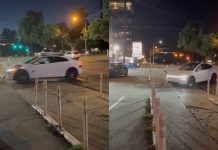
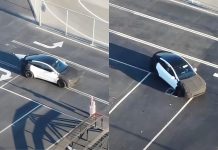
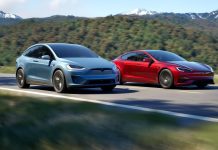









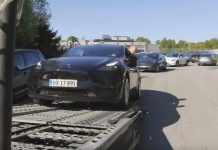

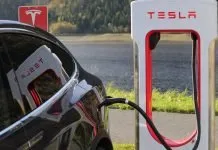

Now, we can accurately calculate the deceleration rate by measuring the braking distance of any vehicle from 60 mph to 0.
you had me until this statement. no can’t. put a parachute on the back when you start breaking and see what happens. dumbest, most flawed test ever. i can’t believe this went to print. you guys are complete morons. put 10 parachutes on the back of a tesla that are released and see what happens again. what comes out of the factory doesnt mean how fast you can make that car break. stupid.